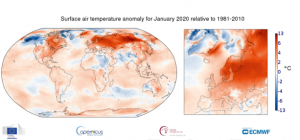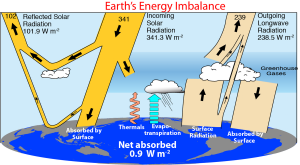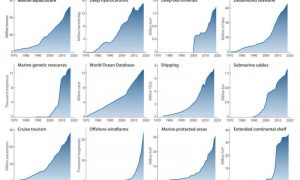Super-scientist Kevin Trenberth on record ocean warming: impacts now and for centuries to come. Then from Stockholm, Jean-Baptiste Jouffray reports on The Blue Acceleration – the rush to colonize the high seas.
Listen to or download this Radio Ecoshock show in either CD Quality (57 MB) or Lo-Fi (14 MB). To download the show, in most systems you Right Click on the link, choose “Save Link As” or “Save As” and note where the file is going.
KEVIN TRENBERTH – OCEAN HOTTER THAN EVER
Scientist Zeke Hausfather (@hausfath) reported this on Twitter, January 13 2020: “Ocean heat content in 2019 was the warmest on record by a sizable margin. Between 2018 and 2019 the oceans absorbed an amount of heat around four times larger than all the energy used by humans in the world.”
Regular listeners know I have been trying to get good information on ocean heating for years. I just know it’s happening, it’s out there, and it is one of the really big, big stories we don’t hear much about. You may wonder why I’m not covering the other “hot” topics, like the novel Corona virus sweeping the world, or America falling into a dictatorship where anything goes. Others are doing that.
We cannot allow ourselves to become distracted, as hard as that is. There will be more and more urgent news, catastrophic storms, fires or floods as climate change unfolds. But if humans cannot muster the patience and perseverance to track the story that could lead us all into extinction, then we will not make it. Whether it’s popular, or gets lots of hits on social media, I will keep digging into our climate emergency – and ocean heating is at the root of it!
Most of the heat from our greenhouse gases has been absorbed by Earth’s ocean. Sea temperatures are rising. Ocean heat content in 2019 was the warmest on record by a big margin. That heat will come back to future generations for centuries. It is leading to more extreme weather around the world right now. Just consider Europe, where there was a heat wave in winter at the end of January. Really, it was summer-like beach weather in Spain, and wildly warm right into Eastern Europe. That was followed by a brief cold snap, and then more heat. It’s a roller-coaster in Europe, with weather never seen before.

The latest study on ocean heat, and the star of this week’s show, is titled “Record-Setting Ocean Warmth Continued in 2019“. That was published in the February 2020 edition of the journal Advances in Atmospheric Science. Dr. Kevin Trenberth is a co-author. Kevin is known as a senior scientist at the NCAR, the U.S. National Center for Atmospheric Research. He is currently on leave, visiting the University of Auckland in his native New Zealand.
The team for this paper was led by Lijing Cheng from the International Center for Climate and Environment Sciences, Chinese Academy of Sciences, in Beijing. Read the full text (free) here.
Listen to download this 30 minute Radio Ecoshock interview with Kevin Trenberth in CD Quality or Lo-Fi
Please pass on this important interview with Kevin Trenberth. If you have friends who only watch YouTube, I have posted a YouTube version of this interview. Some people get most of their information on YouTube, so maybe this will help. I also need more subscribers to my YouTube channel, so that Google will present these interviews higher up in searches.
It’s not like humans can feel the difference in ocean heat when bathing at the beach each year. The ocean absorbs huge amounts of heat and then changes relatively slowly. But there are tipping points where much larger systems could be set into motion. Dying coral around the world, including in Australia’s Great Barrier Reef, is just one example. Declining fisheries is another.
The IUCN (International Union for the Conservation of Nature) says:
“According to an analysis by the Grantham Institute, if the same amount of heat that has gone into the top 2,000 m[eters] of the ocean between 1955 and 2010 had gone into the lower 10 km of the atmosphere, the Earth would have seen a warming of 36°C.”
That is, without ocean buffering, you and I would no longer be here. This new paper by Cheng et al says: “The past five years are the top five warmest years in the ocean historically with modern instruments, and the past ten years are also the top ten years on record.”
HOTTER OCEANS = MORE EVAPORATION = CHANGED WORLD
There are so many impacts of hotter seas. Being humans, we tend to focus on things like losing sea food. But you and I need to understand something else even more important: evaporation from hotter seas. Warmer oceans release more water vapor into the atmosphere. It is a big deal. A larger amount of energy is transferred back toward space by evaporation than by both convection and thermal radiation (combined). See an illustration here.

In recent years, our guest Dr. Kevin Trenberth led a series of papers showing more water vapor can lead to extreme rainfall events and flooding, but also to more damaging hurricanes and typhoons. I was surprised to find in the new paper this about increased evaporation:
“[Evaporation] is one of the key reasons why the Earth has experienced increasing catastrophic fires in the Amazon, California, and Australia in 2019 (extending into 2020 for Australia).”
Trenberth tells us the air above the oceans is 5 to 15% moister than in 1970. Storms grab that moisture leading to more powerful hurricanes/typhoons with more extreme rains and flooding. Even the snow storms over the U.S. and Canadian east coast are worse due to warmer seas. St. John’s Newfoundland is still trying to dig out of a snow dump in January that paralyzed the whole city.

USING SEA SURFACE TEMPS INSTEAD OF GLOBAL MEAN TEMPERATURE…
This paper by Cheng et al says: “Because the oceans are the main repository of the Earth’s energy imbalance, measuring ocean heat content (OHC) is one of the best ways to quantify the rate of global warming.”
Scientists recommend we stop talking about “global mean temperature” as our measurement for warming – and use ocean heat content instead. If 90% of our warming is going into the ocean, and mega-impacts will come out of the sea, maybe we should stop talking about “global warming” and start using “ocean warming” instead. As Kevin explains in this interview, there is a high noise to signal ratio in land temperature measurements (which change drastically), compared to the high signal to noise ratio in sea temperatures. In fact, he says, warming oceans are what really prove the Earth is warming.
If the ocean had not absorbed all the extra heat we create, Earth would be far too hot for humans to survive right now. That’s the good news. But when will that heat come back out of the sea, and for how long? Just like the National Debt, we have borrowed coolness from the sea, but future generations will get our excess heat back – even if we miraculously manage to get off carbon burning now. For me, it’s like the Kings in Medieval times set a heat bomb which explodes in modern civilization now. That is the kind of legacy we leave when we let the ocean absorb our heat pollution, without paying much attention to it.
THE IUCN ON OCEAN WARMING
The International Union for Conservation of Nature has this information to help us understand ocean heating:
“The Fifth Assessment Report published by the Intergovernmental Panel on Climate Change (IPCC) in 2013 revealed that the ocean had absorbed more than 93% of the excess heat from greenhouse gas emissions since the 1970s.”
“Data from the US National Oceanic and Atmospheric Administration (NOAA) shows that the average global sea surface temperature – the temperature of the upper few metres of the ocean – has increased by approximately 0.13°C per decade over the past 100 years.
A 2012 paper published in the journal Geophysical Research Letters revealed that the deep ocean is also affected, with one third of the excess heat absorbed 700 m below the sea surface. Modeling studies published in IPCC’s 2013 Report predict that there is likely to be an increase in mean global ocean temperature of 1-4oC by 2100.”
“The distribution of excess heat in the ocean is not uniform, with the greatest ocean warming occurring in the Southern Hemisphere and contributing to the subsurface melting of Antarctic ice shelves.”
There is breaking news about that hotter-than-expected water underneath some glaciers of Antarctica: “Surprisingly warm water found on underside of Antarctica’s ‘Doomsday Glacier’”
See also: “The equivalent of one atomic bomb per second: How fast the oceans are warming” by Damian Carrington, January 10, 2019, published by the respected Bulletin of Atomic Scientists. Plus this decent article by Kendra Pierre-Louis of the New York Times, “Ocean Warming Is Accelerating Faster Than Thought, New Research Finds” published Jan. 10, 2019, again by Cheng, Trenberth and others. Here is that 2019 study “How fast are the oceans warming?”
The equivalent of one atomic bomb per second: How fast the oceans are warming
===============================================================================================================
THE BLUE ACCELERATION: JEAN-BAPTISTE JOUFFRAY
What are we doing to the sea? Listen to this headline from Stockholm University. “Human pressure on the world’s ocean accelerated sharply at the start of the 21st century and shows no sign of slowing.”
Paul Simon wrote the song “50 Ways to Leave Your Lover”. Well, there are 50 ways to kill the oceans, and we are already engaged in most of them. The real story, as we find out in this interview, is not just that we are using and abusing the sea. We are accelerating all this at unbelievable speed! The Stockholm Resilience Centre and others asked the question: what are we really doing to the sea – and at what rate?
This new study is a master synthesis of all the ways we damage the ocean, the risk of those abuses combining, and four avenues we might try to preserve a living marine environment. It’s huge, and again, pretty well unknown to the public.

Lead author Jean-Baptiste Jouffray, Stockholm
Jean-Baptiste Jouffray is a PhD candidate at two respected Swedish institutions. He is the lead author of a massive analysis of the pace and trends of human impacts on the Ocean. The study was published in the journal “One Earth”. Find an excellent introduction, written by the Stockholm Resilience Center, here. The paper title is: “The Blue Acceleration: The Trajectory of Human Expansion into the Ocean.” This is an Open Access journal, so you can read the full paper, or download it, here.
Listen to or download this 28 minute interview with Jean-Baptiste Jouffray in CD Quality or Lo-Fi
This paper includes a graphic which redraws the globe, to show the claims of all countries, not just on land, but seabed hundreds of miles out from the coast. There is hardly any free ocean left.

Left: land claimed by nations, Right Claims of both land and oceans (from Jouffray et al 2020)
ARE YOU READY FOR OCEAN MINING?
In January 2020, Wil Hylton published a key article in the Atlantic magazine. The title is: “History’s Largest Mining Operation Is About to Begin. It’s underwater—and the consequences are unimaginable.” It looks like ocean mining is supposed to be regulated by the United Nations, but they spun it off to a quasi agency based in the Caribbean, and awash with lobbyists trying to write the most loose regulations they can get away with. You must read this.
The idea behind ocean mining is to grab small bits of metals from the sea bed, concentrated in certain zones, by vacuuming up the whole bottom of the sea. Most of the “waste” (which formerly included key live organisms) is pumped back into the sea, to settle who knows where. It is hard to imagine a more destructive “industry” (other than “mountain-top-removal” mining). Yet some of the investors are pushing open mining as a “green” alternative to land mining. At least we won’t see what is happening, so far out to sea! We need to fight this off.
“LARGE AND ABRUPT TRANSITIONS”
The “Blue Acceleration” analysis investigated the growth of off-shore oil and gas, water desalination plants, shipping, cruise lines and much more. But some of impacts on the ocean come from activities most of us would cheer, like offshore wind, conservation, or gathering more science from the sea. Of course, they could not include everything. For example, the impacts of increased noise on fish and marine mammals, or radiation from places like Fukushima, are not in this paper. Most of us could grasp this study results quickly if we just look at this collection of graphs in Figure 2 of the new paper. Everything is heading up toward the sky since 1995. The public does not realize what is happening at sea.

This team of eminent scientists worries about unknown consequences from this tidal wave of human reach into the oceans. They speak about possibilities like “large and abrupt transitions” with “persistent consequences”. It is a mistake to think we can add all our influences, without realizing their combined effects.
The United Nations is about to declare a “Decade of Ocean Science for Sustainable Development”, starting in 2021. What would sustainable ocean development look like – or do we really need to step back from changing the ocean? Right now the world’s largest banks and investment institutions are pouring trillions into offshore oil and gas. They loan big money to construct new fleets of fishing boats, all heading to rapidly disappearing stocks. Could finance be a bottleneck to control over-use of the sea?
All the possible actors discussed assume a functioning economy with a relatively small number of multi-billionaires willing or able to exert control. What about the rest of us? Don’t we all “own” a share of the sea, and can’t we give our share back to nature? Why doesn’t the ocean have it’s own IPCC – it’s own standing institution to track the health of the high seas? The International Programme on the State of the Ocean, or (IPSO) is unknown to the public and hosted by the Zoological Society of London.
A graphic with the “Blue Acceleration” paper shows several streams of ocean use:
FOOD
Seafood, feed and neutraceuticals
MATERIAL
Hydrocarbons, minerals, desalinated water, ornamental resources, genetic resources, scientific information
SPACE
Shipping, pipelines and cables, tourism and recreation, land reclamation, renewable energies, geoengineering, waste disposal, conservation, territorial boundaries, military activities
All of these take place within a shell composed of: Climate change, population growth, declining land-based sources, geopolitics, increasing consumption trends, and technological advances. The Jouffray papers says:
“As the capacity to industrialize the ocean grows, marine ecosystems face unprecedented cumulative pressures from human activities and climate change. Ocean acidification, marine heatwaves, plastic pollution, and ecological connectivity all transcend political boundaries, making the sustainable governance of marine resources a uniquely international responsibility.”
RECLAIMING LAND (EXTENDING OUR LAND INTO THE SEA)
Humans in many nations are “reclaiming” land from the sea, i.e. converting the sea to land, in many countries around the world. This has been a historical trend, from Boston to Tokyo to the new islands built in the Pacific by China. The paper says: “China, in particular, is leading the world in large-scale reclamation projects, extending its coastline by hundreds of square kilometers every year.” The reference for that is: “Drivers, trends, and potential impacts of long-term coastal reclamation in China from 1985 to 2010″.
SEA-BED GRABBING (from an illustration with this new paper by Jouffray et al) “Box 1. Seabed Grabbing”
“One of the most significant geopolitical transformations in recent times is occurring in the ocean depths. Article 76 of the United Nations Convention on the Law of the Sea (UNCLOS) allows countries to claim an extended continental shelf to explore and exploit the resources of the seafloor beyond the 200 nautical miles of their exclusive economic zone.
Since the first claim was made by Russia in 2001 concerning the Arctic region, submissions or preliminary information from a total of 83 countries have been sent to the UN Commission on the Limits of the Continental Shelf, together encompassing more than 37 million km2 of the seafloor . This is more than twice the size of Russia — the world’s largest country — and nearly 80 times the reported global area of ‘‘land grabs’’ since 2000 (www.landmatrix.org).
In many cases, the territorial basis of a state is made of more seabed than land. Small island developing states are indeed becoming large ocean states. The Cook Islands, for instance, has claimed an area of extended continental shelf equivalent to 1,700 times its land surface. Countries that include islands and overseas territories are benefiting in particular from Article 76.
Remarkably, Australia was able to secure more than 2.5 million km2 of additional seabed thanks to Heard Island and the McDonald Islands, two uninhabited territories of 368 and 2.5 km2, respectively.
This recent surge in submissions has also given rise to several overlapping claims, adding an extra dimension to maritime disputes and foreshadowing the need for future negotiations on boundary delimitation agreements.”
Jean-Baptiste Jouffray, a bright young scientist works with both the Global Economic Dynamics and Biosphere programme [GEDB] at the Royal Swedish Academy Of Sciences, and the Stockholm Resilience Centre. This paper is really a follow-up to 2017 science from the Stockholm Resilience Center. I interviewed Owen Gaffney about “The Great Acceleration” for Radio Ecoshock. Find that interview and show here.
Please pass this new program about ocean heating to your friends, through Facebook, Soundcloud, YouTube and Twitter. We need to keep this news going public, despite the latest disease, disaster, and political chaos.
I also appreciate any financial support you can give, to help keep this program going out free to radio stations and people all over the world. You can also contribute your story ideas, using the Contact form on this web site.
Please join me again next week for more Radio Ecoshock.
Alex
You may wish to consider guesting Jim Massa oceanographer who has much to say about the effects of absorbed ocean heat content & ocean stratification & how the latter affects/threatens the vital marine balance of phytoplankton. His overall theme is that too many overlook the fact that the oceans dictate the global climate & weather patterns.
So, whilst most of today’s foremost climate scientists concentrate on the greenhouse gas lithosphere/atmospheric heating impacts, Jim’s concerns are that ocean heat content has already passed a significant tipping point fueling self-reinforcing feedback loops in the Arctic region.